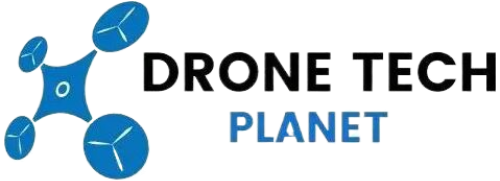Drone Parts And Components Overview With DIY Tips
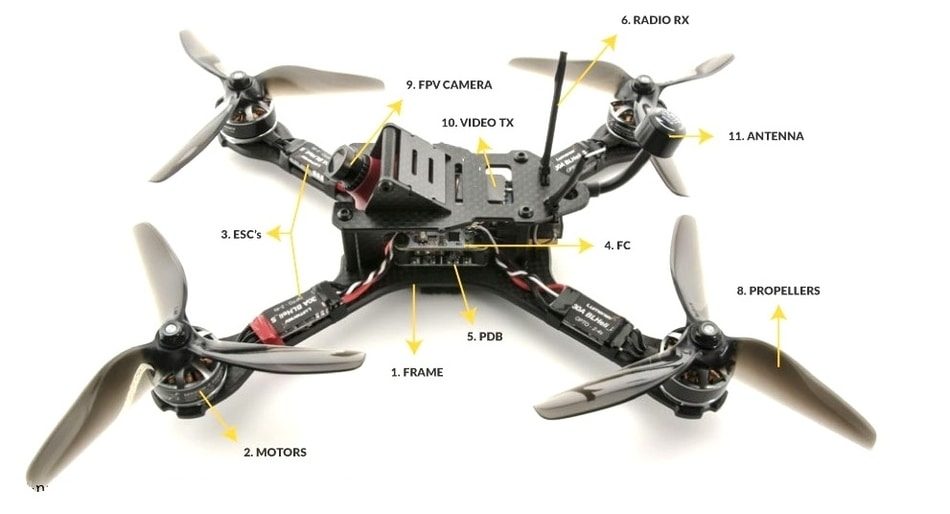
Every drone must be designed so that all components and parts are vital for a smooth and safe flight. Therefore, knowing the drone parts will help us understand how they operate and also give us an extra confidence during the flight. If something happens to our drone, we’ll understand much better which parts are essential and how to replace or upgrade them.
What inspired me to write this article is the excellent diagram I came across while researching drone components from an article that is called “Anatomy of a Drone” by MakeZine. Although his article only includes basic components, I have added extra informations and upgraded it, so you can better understand each quadcopter part and component. Let’s go to see what are the main components that make up a modern drone.
Drone Parts & Components Overview – Intro
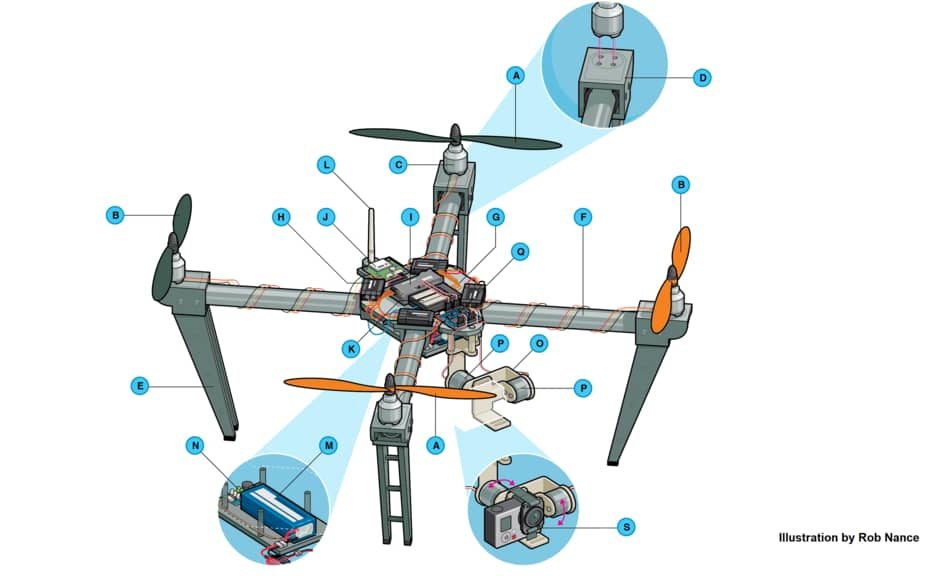
Modern models of drones can be as simple if they are intended for entertainment purposes, or they can be composed with complex components that allow turning these aircraft into truly professional devices.
While the internals of a drone may differ from model to model, the basic drone components are always the same. In general, each drone can be divided into the following parts.
> Get Latest DJI Phantom 4 PRO HERE <
Complete Drone Parts & Components Overview:
- Standard Propellers (A)
- Pusher Propellers (B)
- Brushless Motors (C)
- Motor Mount )(D)
- Landing Gear (E)
- Boom (F)
- Electronic Speed Controllers (ESC) (G)
- Drone Frame (H)
- Flight Controller (I)
- GPS Module (J)
- Receiver (K)
- Antenna (L)
- Battery (M)
- Battery Monitor (N)
- Drone Gimbal (O)
- Drone Gimbal Motor (P)
- IMU (Q)
- Sensor (R)
- Camera (S)
- CPU (T)
- Active Tracking (Follow Me Mode) (U)
Drone Parts And Components – Complete Overview
A) Standard Propellers
Standard props are the propellers that are at the front of the drone. Their main role is to pull the drone through the air. Propellers on most drones are made of plastic, while better models have propellers that are made of carbon fiber.
Some models come with prop guards and can protect your propellers and others from unwanted injuries. A very important feature of propellers is their design and size. Better design propellers can give a smoother flying experience, low noise, and longer flight time.
The technical characteristics of the propellers have two values: The length of the blades and the geometric pitch, expressed in inches.
To summarize, there are 2 types of propellers:
- Large Prop = a lot of lift → stable flight but needs the power to make 1 full turn
- Small Propeller = little lift → less stable flight and needs less power to make 1 full turn
The size of the propeller is based on the lift (ie the mass to fly) that we need. For a quadcopter for example, the size varies between 8″ and 13″ to you have to take into account the size of the frame: For a 30 cm frame we can climb 9″ max, on 450 cm we can climb 12″ max.
- Small step = greater traction at low speed, but limited maximum speed.
- Large pitch = smaller traction at low speed, but high maximum speed.
For a quadcopter, the average is 4.5″. However, it is possible to go down to 3.5 (for slow flight) or go up to 6 (for fast flight).
Tip: Always inspect your propellers before each flight and carry extra sets if you notice any damage. Never fly with a bent or damaged propeller.
Related Article: How A Quadcopter Works Along With Propellers And Motors
B) Pusher Propellers
The Pusher props are located at the back of the drone and they push the UAV forward. That’s where they got the name “Pusher props”. Rotation for these props are established when a propeller is rotating clockwise (CW).
The principle of how these contra-rotating props work is that they cancel out motor torques when the drone is flying stationary, while the opposite pitch gives downdraft. They can be made of plastic, while the better pusher props are made from carbon fiber.
Tip: Same thing as for standard props. Inspect your props before each flight and make sure to have a spare set.
C) Brushless Motors
Your quadcopter will not fly anywhere without motors; to a large extent, it is they that determine the flight capabilities of the device. The reason brushless motors are used is that they save battery life and give the pilot more flying time. Unfortunately, their technical characteristics are not very clear to most novice pilots. Most quadcopters use brushless DC motors, although cheaper models often use brushed motors.
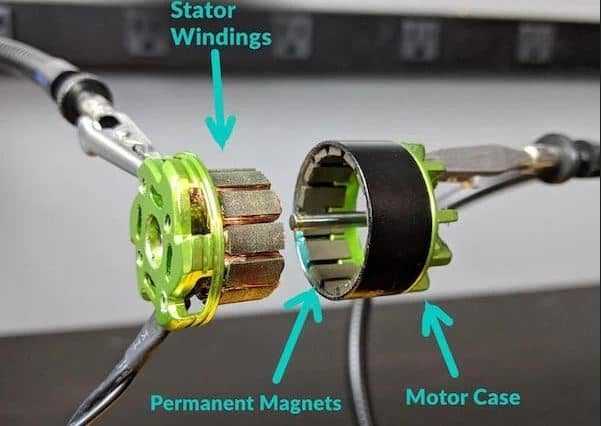
Brushless motors consist of a permanent magnet armature and a series of coils surrounding it. Brushless motors can have 2 to 14 poles. The more poles, the more precisely the motor can be controlled.
The key characteristic of a quadcopter motor is the kV value. kV is the nominal number of revolutions per minute (RPM) that the motor will make at no load when a 1 volt potential difference is applied to it. Low kV motors deliver high thrust and are mounted on heavy drones with large blade diameters. Small drones use high kV motors.
Another important factor is the rated current of the motor. You must know its meaning to select the right ESC and battery. The rated thrust of the motor depends on the propeller size. The basic rule of thumb is that the combination of motor and propeller should deliver twice the thrust of the drone.
> Get Latest DJI Mavic 3 PRO HERE <
Tip: Make sure to check your motors regularly. They must be clean and free from dust. Motors produce sound, so knowing how your drone sounds during the flight is good.
Note! If you are building a quadcopter from scratch, there is a detailed video at the end of this article that you can watch.
If you want to know more about how drones fly, I wrote an article Physics Behind How Drones Fly. You will get much better insight on how drones fly and what is the physics behind them. Therefore, I advised that you read this article as well.
Top quadcopter motors and propulsion systems that have the following drone components:
- Motor Bell (rotor)
- Motor Stator
- Cooling System
- Windings
- Bearings
- Propellers
- ESC (Electronic Speed Controllers)
- ESC Updater
- Arm
- Wiring
D) Motor Mount
The drone motor mount is part of the quadcopter frame and is built into the combination fittings. On some drones, it is very easy to replace the motor mount. Here you can see how fast and easy you can replace it on the Parrot AR Drone.
Also, try to examine areas around your motor mounts where screws are used. If the screws are too tight, they can crack the frame of the drone. They are not expensive and can be easily found online. This is an important drone part.
Note! It would be good to check motor mounts that are close to the motors for stress cracks often. If you notice some cracks, you need to fix them.
E) Landing Gear
While not all drones have a landing gear, it certainly does belong to drone parts and drone components, so we include it on our list. Drones that need high ground clearance and have camera that is mounted at the bottom (example DJI Phantom) most oftenly use style skids that are mounted to the body of the drone.
But unlike the DJI Phantom, many fixed-wing drones such as DJI Spark, Trimble UX5, and other racing drones, don’t have landing gear and they land on their belly. However, most professional and selfie drones come with retractable landing gear so they can have the perfect 360 degree view when they are in the air.
Note! Keep in mind that for most drones, you can buy and attach leg height extenders. This is very useful if you are flying in areas with long grass or uneven surfaces.
Retractable Landing Gear Drones
- DJI – Matrice 600 Pro
- DJI – S800
- Walkera – QR X900
Note! Examining your landing gear every time you’ve had a rough landing is important. By this, you will protect your drone and the cameras built into it.
F) Boom
The boom presents the main body of a drone. When the drone have shorter booms it increases the maneuverability, while the longer ones increase stability. It is very important that booms be tough so they can hold up in a crash. Some models have a definite boom as a separate part.
Tip: Keep in mind that the boom should not be bent as this would greatly affect the flying capabilities of a drone.
> Get The DJI Mavic Air 2 deal HERE <
G) Electronic Speed Controllers (ESC)
The device that controls brushless DC motors is called an electronic speed controller or ESC. One copy is installed on each engine. The main task of the electronic speed controller is to transfer energy from the drone battery to the brushless motor.
ESC must be rated for the maximum current drawn by the motor. It is always best to choose an ESC whose rated current is higher than the maximum motor current.
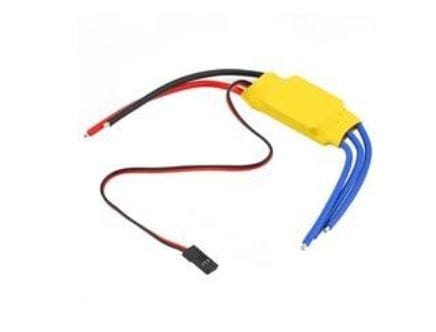
The need for their use arose due to some features of the BC – motor. In short, the battery supplies direct current, while the brushless motor accepts three-phase alternating current. Every modern drone MUST have ESC, because they are essential for almost every drone that have high power, high resolution 3-phase AC power and a high frequency.
DJI introduced massive leap in ESC innovation, when they release Inspire 1. They added new sinusoidal drive on ESC. Also, what DJI Inspire 1 added was closed loop torque control together with distinct functional redundancy, which gave additional reliability and efficiency to the motors. Therefore, ESC is considered very important drone component.
Note! The place where the ESC is located is inside the main frame of the drone. Some drone manufacturers such as DJI, Parrot and Yuneec develop quadcopters that can be customized.
H) Drone Frame
The frame represents the skeleton of the drone. Every idea for building a drone starts with choosing a frame on which all the necessary components will be mounted. The quadcopter frame can be made from various materials such as: wood, aluminium, plastic, or carbon fiber.
The flight style and performance characteristics depend on the frame form factor. You can assemble a quadcopter for FPV racing at high speeds and a drone for video shooting of landscapes and panoramas, which can hover in the air and carry an action camera or other equipment. Carbon frames are lightweight and highly durable. Plastic frames are used to assemble micro quadcopters with brushed motors.
The frame can be purchased directly, while DIY enthusiasts can build it from “home-grown” components or even create it with a 3D printer. The frame can be a single piece or several assembled pieces. A feature that makes it easier and less expensive, in case of breakage, you can replace only the damaged parts.
Tip: Keep in mind that most drones are not waterproof so keep them away from water and rain so they do not get wet. Also, a hard landing or a crash can break the drone frame and damage the components in your drone.
I) Flight Controller
The flight controller is considered to be the brain of the quadcopter. This device controls the speed of the motors by sending signals to the ESC. Controller also controls waypoints, autopilot, follow me mode, and many other functions on a drone.
Advanced flight controllers have more capabilities and are linked to sensors such as gyroscopes, accelerometers, sonars, GPS, IMU, and magnetometers. Simple flight controllers contain only gyroscopes and are sufficient for most beginners.

The simplest drones usually can only control the rotation of the motors depending on the incoming commands, while the most professional drones, for example, can independently return to the launch point.
The basic composition of the flight controller are the following:
- Main processor – responsible for processing commands
- Gyroscope – sensor for determining the position of the drone in space
- Borometer – a device that determines the height of the position of the apparatus
- An accelerometer is a device that analyzes the acceleration of a device in three planes (x, y, z).
- Direction Arrow – indicates the direction in which the drone should fly (located in one of the corners of the base of the board)
- GPS Navigator – determines the location of the drone
- Wi-Fi – for communication with external devices (tablet, smartphone, PC)
- RAM – Random-access memory
Note! In most cases drone owner’s won’t need to adjust or modify the flight controller. Advanced flight controllers have the ability to be customized, although this is not recommended.
J) GPS Module
The GPS module is an important part of the navigation and positioning system. The GPS stands for Global Positioning System. If this module fails, normal operation of the drone is not possible. The most common cause of breakage is a fall. The module allows the quadcopter to track its current position and speed. For better positioning accuracy, the module antenna needs an open sky view, and therefore, it is not recommended to use GPS mode indoors.
The GPS (Glonass) module is installed directly on the main board of the quadcopter from above and is attached to it with screws. Glonass is a new technology in GPS that allows drones to find more satellites so it can get better positioning form.
When additional modules are connected to the bottom expansion board, their loops dock with the connectors on the top of the GPS module, thus connecting to the main board “through” the GPS module.
The module is also equipped with a compass for accurate orientation in space. Compass readings can be distorted near massive metal objects and buildings. In short, with GPS (Glonass) you can fly accurately and safely and don’t need to worry about losing satellite connection.
Note! Most new drones allow you to set your home point if something happens to your drone during flight so the quadcopter can return to its home position. Also, most drones have a limit for a minimum of required satellites before the home point can be set.
K) Receiver
To fly a drone, you will need a radio transmitter for the pilot and a receiver in the drone. The receiver will simultaneously receive the signals from the various controls (the channels). He is able to differentiate them and to reassign them to the action which falls to him.
The receiver can receive up to eight different instructions, allowing more precise drone control. Therefore, the receiver definitely needs to be included in the drone parts.
A radio control should ideally have 6 channels for piloting a drone, 4 channels on the joysticks and 2 channels on switches to activate certain functions. You should know that different protocols manage the radio depending on the brand.
These receivers can only be used on one frequency. Ultimately, each drone has its own remote control and it can only be used with that model, and cannot be adapted to others.
L) Antenna
The main job of the antenna is to convert the electrical signals into electromagnetic energy. Anything that is wireless, like a drone, must have an antenna (transmitter) and a receiver antenna. Antennas play a big role in a good quality video feed from a drone.
Therefore, a good choice of video antenna is essential to establish the best possible connection between you and your quadcopter. The omnidirectional antenna is the “basic” antenna that will work on flat, open terrain.
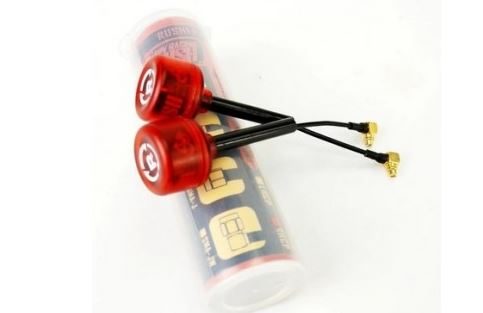
Note! Antenna’s are very easy to upgrade on a drone. A circularly polarized cloverleaf antenna will give much better video signal distance and will improve the video stability on the drone.
M) Battery
The batteries that are used on a drones are essentially Lithium Polymer (LiPo) batteries. LiPo batteries have technology that have a very good weight/power ratio. This means they offer the best combination of power density, energy density and lifetime in one. A LiPo cell (1S) supplies a voltage of 3.7V. On a drone, we generally use batteries with 3 or 4 cells (3S or 4S).
Due to the low capacity and small size of the battery, mini drones can stay in the air for no more than 3-5 minutes. Comercial drones are able to fly for about 12-15 minutes. The duration of the flight of professional drones in autonomous mode is no more than half an hour.
Intensity is also a criterion of choice. A 3000 mAH battery will have better battery life than a 2200 mAH battery.
A specific charger need to be provided as well as very strict safety rules because these batteries can explode in the event of improper handling.
Tip: From my personal experience I can tell you that it is wise to carry a spare battery with you. Also, get acquainted with the instructions of using the battery, how it should be stored, at what temperatures it should be and for how long. Always after flying check that the battery doesn’t overheat.
N) Battery Monitor
The battery monitor lets you monitor your battery level so you know at all times how much battery power is left. Otherwise, You’ll find yourself in a situation where the battery voltage will drop enough so it can no longer maintain your drone in the air and your drone will crash.
The batteries are very sensitive and discharge quickly, so it is necessary to have an insight into the battery’s condition at all times. None of us want his drone to crash because he hasn’t kept track of how many batteries is left.
Note! It is very important that you know what is the flight time of your drone, and how long it can stay in the air. Each time the battery gets below 20%, it is best to lower the drone to the ground and replace it with a new battery.
O) Drone Gimbal
The mechanics of the gimbal are simple. It essentially consists of rings that rotate at right angles (x,y and z) around the camera, which helps keep the device steady while the drone is moving. Since drones are used for a wide variety of purposes requiring decisive action, the use of a good gimbal has become imperative. Therefore, the correct choice of drone gimbal is extremely important if you want to take professional videos or photos.
Just as there are many different drone models, there are also different types of gimbals available on the market. Some are geared towards the extreme photography enthusiast, while others cater to the demands of amateur pilots looking for a first-person perspective. Drones are generally available with 2- and 3-axis camera gimbals. Each of these types has its own pros and cons.
Note! If your drone doesn’t have a great gimbal, then even the best camera won’t help you. The great gimbal is important if you want to take great photos and videos with your drone.
P) Drone Gimbal Motor
Drone gimbal commonly use three motors that work together to keep everything stable and to avoid any vibration during the flight. Most gimbals use brushless DC motors for direct drive angular positioning.
For this reason, any horizontal vibration from the drone is completely eliminated. For aerial photographers and filmmakers, a 3-axis gimbal is an absolute must. Additional batteries will become a necessity if you are flying with a 3-axis gimbal.
Q) IMU
The IMU, or Inertial Measurement Unit, consists of a set of electronic components that are essential for the operation of the drone. This part may include GPS antennas, gyroscopes, accelerometers, barometers, etc, inertial measurement instruments, which allow the Flight Controller to improve the response to sudden changes in the recorded factors.
R) Sensors
Most modern drones are equipped with a variety of sensors to meet the market standards. Each sensor has a different role. There are LIDAR sensors, accelerometers, tilt sensors, current sensors, engine intake flow sensors, thermal sensors, avoidance obstacle sensors, and many others. For example, one of the most commonly used sensors are those that come with GPS, and are used to create 3D photogrammetry images.
The sensors also serve to protect drones from collisions, especially when new drone pilots are flying for the first time. We can freely say that sensors are a very important part of drones and belong to the ‘must have’ equipment.
S) Camera
Today, the camera is considered a must-have accessory on every drone. At the moment, there is a whole segment of professional drones on the market, that are equipped with specialized video equipment.
To install a video camera, drone must have a special suspensions, which are movable hinge-type mechanisms. Such mechanisms (Gimbals) allow ensuring reliable fixation of the camera and they almost completely eliminating vibration during the flight.
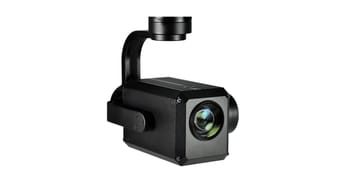
Some drone manufacturers like DJI have taken gimbal and camera technology very seriously, and they provide the best video quality on the market. A radio-controlled drone that is equipped with a video camera allows using FPV (first person view) to guide the shooting process not blindly, as it is usually done, but focusing on the resulting picture. The video picture is transmitted in most cases over a Wi-Fi network.
You can also take a look at DJI and Hasselblad, which are the leaders in high-quality medium format cameras, and see their first 100-megapixel drone platform.
Tip: If you are buying a drone to take aerial shots, buy DJI Phantom 4, or another professional drone with a quality camera. Note that drones have an integrated gimbal to get a quality image while flying.
T) CPU
The CPU is the motherboard that is able to manage every movement of the drone and all internal and flight procedures. We can say that CPU is the “brain” of the drone, that is able to give the commands.
Inside the CPU, there are many sensors that ensure a completely safe flight such as:
- the gyroscope;
- the accelerometer;
- the compass;
- the gps;
- the barometer.
But not only that, the sensors that can be part of the CPU are really many, based on how professional the drone is. This drone component is crucial.
U) Active Tracking (Follow Me Mode)
Follow Me mode allows the drone to follow a particular object or person while it is moving. This is the technology which is integrated on the processor inside the drone. These same drone components and algorithms that are used in the drone allow him to navigate it to track the object and in parallel avoids obstacles along the way.
For example, the pilot can tell the drone which object or person he needs to follow. If you activate the Follow Me mode on your drone , it will track both people and objects by itself. This setting is useful, but not always an advantage.
- In order for you to get beautiful pictures, the drone tries to place the objects to be tracked in the center of the picture. However, this does not work reliably because reading out the GPS data often takes too long.
- Nevertheless, the mode can be useful for beginners in order to get good first pictures. You can also try different altitudes during the adjustment.
Drone Parts And Components Videos
For the end, I have prepared 2 interesting videos for you. In these 2 videos you will see how these components look in real and where exactly they are located in the drone. In this article, we have described each of these components separately, and now you will see their application in the real world.
This next video will show you components that are inside a DJI Phantom 3.
Final Thoughts
At the moment, the varieties of drones on the market are impressive. It can be the small drone for children, amateur drone with a camera, professional drone or a racing drone. However, all these drones have more or less the same components that are necessary for its operation.
In this article we have gone true all the parts and components that every drone must have. I hope that you now have much better understanding of what drones are made of.

